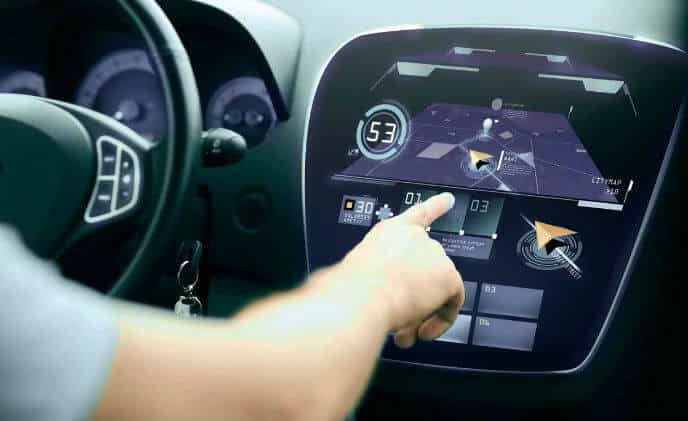“What is the best way for me to implement a telematics system for my fleet?” This is one of the most common questions we hear. Even though the telematics market is expected to grow to over $62 billion by 2025, up approximately 16% from 2020, not everyone in the industry is familiar with how telematics functions. Telematics, which includes GPS monitoring, is a great tool for fleet management firms to keep tabs on their vehicles, tools, and personnel (it may be more important now than ever in our post-COVID era). In this article, we will discuss the telematics control unit, insurance, devices, and the benefits of telematics.
What Is Telematics?
Telecommunications and computer technology come together to form the field of telematics. In common usage, it is described as “the combination of computing and wireless telecommunications technologies with the aim of efficiently transferring information over massive networks to enhance a range of services.”
During the height of the Cold War in 1978, a United States Government Technology report introduced the world to the concept of “telematics.” GPS was developed for military and intelligence use because of national security and nuclear threat concerns. Yet, it wouldn’t be long before significant research initiatives started experimenting with vehicle telematics to boost traffic safety and lessen carbon emissions.
The modern definition of telematics is closely linked to the practice of tracking automobiles and other assets when real-time knowledge of their whereabouts is crucial to the smooth operation of a business. Technology such as GPS tracking is an example of telematics used in contemporary fleet management.
How Does Telematics Work?
In order to transmit, receive, and store telemetry data, the devices that make up a fleet management telematics system are installed in the cars that make up the fleet. A SIM card establishes a connection with the onboard diagnostics system or CAN-BUS port of a vehicle. The information is transmitted via a wireless network through an inbuilt modem.
This information is then sent to a centralized server via General Packet Radio Service (GPRS), 4G (soon to be 5G) mobile data and cellular networks, or satellite connection. The device also gathers a variety of vehicle-specific data in addition to GPS fleet tracking data. However, the information is received by the server, which then displays it on a protected website that can be viewed using mobile devices such as tablets and smartphones. The transfer of information between the telematics provider and the car is managed by a business that specializes in telecommunications.
The device is able to record a variety of data, including the location of the vehicle, its speed, any hard acceleration or braking, the amount of time it spent idling, fuel consumption, and an assessment of the engine’s overall health. The information, after being evaluated and processed, can provide you with in-depth insights into your whole fleet.
What Are the Types of Telematics Systems?
Generally speaking, there are six distinct categories of telematics systems:
#1. Black Box Telematics Systems
As the de facto standard for UBI projects in the United Kingdom, “black box” technology collects and generates a stream of data from connected vehicles. Black boxes, or other permanently placed electrical devices, safely put within a vehicle, record and send data about the journey and any accidents that may have occurred.
This method is often used in places where auto theft is frequent since it is a tried and true method that can’t be easily circumvented and results in the prompt recovery of stolen vehicles. However, these auto-parts accessories need to be professionally fitted in vehicles, which drives up construction prices.
#2. Obd Ii Telematics Systems
One of the earliest developments in the field of vehicle telematics was the On-Board Diagnostics (OBD-II) functionality, which has been mandated on all vehicles sold in the United States since 1996. Similar standards can be found in Europe, where they are referred to as European On-Board Diagnostics (EOBD).
Being a long-standing, well-known workaround, fully plugged-in OBD devices have established credibility and reliability in the market. In most cases, drivers’ information is sent instantly over mobile networks. An affordable option, this can be used in conjunction with smartphone connectivity to enhance passenger-driver engagement.
#3. 12V Plug-in Self-Installation Telematics Systems
The 12v outlet in your automobile is the power source for these tools, and they also require no installation. In the same way, that data from onboard diagnostic (OBD) devices is reliable, the data from these devices is. Similar to OBD devices, these can be dangerous if not properly secured by the “technician.”
The gadget might be easily damaged by accidental drops. Also, users may be tempted to unplug it so that they can utilize the 12v socket for something else. To counteract this, some models feature tamper-detecting technology and USB ports on the 12v plug.
#4. Bluetooth-Powered Telematics Systems
In addition to a black box or mobile phone app, many telematics devices now have Bluetooth data transmission that does not require an external power source. These devices can be put in the car’s center console and send driving data to your insurance company via Bluetooth. Although Bluetooth devices generally send important data to servers for in-use insurance systems.
#5. Smartphone-Based Telematics Systems
The widespread availability of smartphones has simplified the collection of demographic information. A smartphone-based driver assistance system doesn’t need any configuration, unlike a traditional black box. Easy-to-use mobile telematics devices provide accurate data to your insurer, who may then tailor your premiums to how you drive.
#6. OEM Hard-Wired Telematics Systems
Market acceptance has been slowed by a lack of uniformity across Original Equipment Manufacturers (OEMs), despite the fact that data collected directly from built-in sensor devices eliminates the need for aftermarket setup.
Be on the lookout for future programs built on this preexisting functionality, which will lead to highly dependable data collection, unique ways to monitor driving, and integration with driver-assistance features. There will be fewer and fewer severe accidents as a result of this improvement in safety.
What Is Telematics Control Unit?
A telematics control unit, also known as a TCU, is an embedded device that is found in the automobile industry. Its purpose is to connect a vehicle wirelessly to cloud storage or to other vehicles using the V2X standards that are transmitted through a mobile network. The Telematics Control Unit is able to collect telematics data from the car, such as location, speed, engine data, connection quality, and so on, by connecting with various subsystems in the vehicle via data and control buses. Examples of telematics data include location, engine data, and connection quality. Moreover, it may include in-vehicle networking capabilities via WiFi and Bluetooth, in addition to the potential to make eCall calls in particular regions.
The following are the parts that make up a telematics control unit:
- A device for analyzing and modifying electrical signals
- A storage medium for crucial data, such as a memory card
- Positioning and navigation through satellite
- In other words, a microcontroller
- A cellular communication accessory
- Power supply module
- A portable data hub
How Does Telematics Control Unit Works?
The Telematics Control Unit is connected to the vehicle’s numerous subsystems via data and control buses in order to collect information about the automobile, such as its location, acceleration, engine statistics, connectivity quality, and so on. It is common practice to position the Telematic Control Module (TCM) in the middle of the vehicle, behind the dashboard. Alternatively, you might look in the vehicle’s storage area, such as the trunk or the area behind the rear seats.
The Telematics Control Unit is a device that is installed in vehicles and communicates with the car’s electronic control units (ECUs), a global positioning system (GPS) satellites, and telematics services through a wireless network.
With the help of GPRS (General Packet Radio Service), 4G mobile data, a mobile network, or a satellite link, the gadget may gather GPS and other car signals and send them to a central server. Data is evaluated on the server and delivered to consumers using encrypted mobile web and app platforms.
Data such as location, velocity, harsh acceleration/deceleration, average speed, gas mileage, and vehicle problems can all be gathered by telematics systems. In addition, Analysis of this data for specific occurrences and patterns can yield useful insights for an entire fleet.
A Telematics Control Unit’s Roles
- Telematics cloud server allows for easy management of bidirectional communication.
- Get information from the CAN-BUS interface in the car.
- Control data exchange with the human-machine interface
- Memory and power management
- Collect data from multiple sources of contact and manage it effectively.
What Is Telematics in Insurance?
Telematics insurance, or usage-based insurance (UBI), refers to the practice of utilizing tracking devices to determine or modify insurance premiums for motor vehicles. There is mileage-based insurance, which uses your yearly mileage as one factor in determining your premium, and there is also behavior-based insurance, which rewards safe driving with lower premiums.
Car insurance premiums are increasingly determined by data collected from in-car tracking systems, external devices, and mobile apps.
How Does It Work?
Telematics insurance packages for cars monitor your driving habits and provide you with a safety score based on that information, as well as keep track of your kilometers driven. In order to determine your risk level, the programs record information about your driving habits, schedule, and locations. Lowering your risk of being involved in an accident and so lowering your auto insurance costs is a win-win situation.
What Are the Different Types of Telematics Insurance?
The most common sort of telematics insurance uses a device installed in the car called a telematics box, but there are other ways in which insurance firms can track your driving behavior.
#1. Pay-Per-Mile
With a pay-per-mile policy, your insurance premium will be modified according to the number of miles you travel each year. Your insurance premiums can go down if you reduce your mileage driven. A monthly price covers you for parking lots, but if you go beyond a particular mile, you have to pay more. However, to gauge how far you are from something, you can use a tiny device or a mobile app.
Whether you are a competent driver or not, the amount of time you spend on the road is a major contributor to your accident probability. In addition, Pay-per-mile plans to adjust your payments based on how far you travel.
#2. Plug-And-Drive
Comparable to a telematics box policy, but with the added convenience of DIY installation, plug-and-drive policies allow drivers to monitor vehicle data with a small, in-car computer. You’ll receive a device in the mail from your insurance company to put into your car’s 12v power outlet, usually known as the cigarette lighter. Your velocity breaks and turns are all recorded by the gadget.
#3. Telematics App
With a telematics app policy, your insurer can monitor your driving habits by installing an app on your smartphone and collecting data. Furthermore, to track your velocity, acceleration, and location, this software makes use of your mobile device’s global positioning system.
Who Is the Largest Telematics Company?
Geotab. Among commercial telematics providers, ABI Research ranks Geotab as the market leader.
Benefits of Telematics
Simplifying operations, enhancing driver management, and realizing a strong return on investment are all made possible by the vast amounts of data collected and stored by modern telematics systems. So, here are some of the benefits of telematics:
#1. Better Fleech Performace and Efficiency
Telematics gives you real-time data on the position of your vehicles, allowing you to determine which routes are the safest and most efficient. This allows you to increase delivery speeds while simultaneously reducing the amount of money spent on fuel. In addition, geofencing allows you to monitor performance in comparison to timetables and investigate the causes of any delays that may have occurred.
#2. Vehicle Tracking
A combination of GPS satellites and receivers, GPRS networks, and cloud computing can provide you with precise information regarding the location of your vehicles. Installing a telematics device enables a GPS receiver to communicate with the GPS satellite network and retrieve data. After that, it is processed and sent over GPRS to secure servers, where it may be read and utilized to reroute and dispatch the closest driver to a new task.
#3. Enhancements to the Maintenance Department
Fleet administration Better fleet vehicle maintenance can be achieved all throughout a vehicle’s lifecycle with the aid of telematics. With telematics, you can monitor your car’s mileage and schedule maintenance before any major issues arise from frequent driving. However, you keep vehicles running safely by adhering to a preventative and predictive maintenance schedule informed by engine diagnostics provided by telematics devices. It is possible to track issues with the engine, batteries, intake valves, coolant, and oxygen sensor.
#4. Fully Clear and precise Communication
The flow of information between drivers and fleet managers can be streamlined with the use of telematics. Accurate arrival time estimates and higher customer satisfaction can be achieved by better communication, precise vehicle location, and geofencing. For businesses operating in highly competitive markets, a dissatisfied client base is a quick and easy way to lose sales and market share. In addition, you can gain an advantage over the competition by improving communication and tracking vehicles in real-time.
#5. Efficient Handing of the Payroll System
The use of a telematics solution can help cut down on overtime and timesheet fraud. By keeping tabs on electronic time logs and allocating resources in real-time, you can cut down on fleet-wide overtime. Drivers’ routes can be optimized to cut down on unnecessary travel time. You will also have precise data on the number of hours and mileage by each vehicle, which is useful for calculating salaries.
#6. Maintain a Regular Schedule for Drivers
Do drivers follow their schedules and departure times? The use of fleet telematics provides a crystal-clear response to this crucial question. With records of where drivers are at any given moment, and where their vehicles have been at any given time, fleet managers have the information they need to verify if drivers are following proper routes and timetables.
A delivery or service truck making an incorrect stop could happen more often than you think. The driver might be slightly disoriented while trying to find the right address, but that’s the best-case situation.
The worst-case situation is that the driver and crew begin unloading freight or attempting to complete the work order in the incorrect place. In addition to costing you money and making your customer wait for service, this strategy is inefficient.
As a service vehicle checks in to begin a work order or delivery, the location of that vehicle can be tracked using telematics to ensure it is headed to the correct location.
Furthermore, if a dispute should emerge at a later date, the GPS monitoring data can be used to verify whether or not the vehicle was present at the job site at the scheduled time. This aids in settling disagreements quickly, so that you can get back to running your business.
Telematics Device
An insurance company may supply you with a telematics device to install in your vehicle. It records information on your driving style, including how fast or slow you go and how often you brake.
A plethora of smart vehicles and cellular programs rely on the ubiquitous availability of telematics devices for data collection. The onboard diagnostic (OBD) device lets drivers track and record their driving patterns in real-time. This data can include things like average speed, total distance traveled, and occurrences of forceful braking.
Where Can I Purchase a Telematics Device?
Putting a telematics device in your car is possible through a number of different routes. Buying a car already equipped with one is the first option. This feature might already be standard on more recent models.
If your vehicle doesn’t have this capability built-in, you may easily add it by purchasing a gadget from an electronics retailer or even online and installing it yourself. Programs like Drive Safe & Save and SmartRide, offered by your insurer, may also make a certain model available to you. So it’s time to get in touch with a sales rep for a car telematics system.
Safe driving strategies use many factors, including telematics devices. Aftermarket security accessories, such as dash cams and anti-theft gadgets, can further increase your vehicle’s safety.
What Is the Difference Between Gps and Telematics?
The backbone of the telematics system is GPS tracking. Each vehicle has a GPS receiver, which looks like a black box, fitted underneath the dashboard to track its location and record its status in real-time. The fleet system’s central server receives GPS tracker data via the telematics system from the cellular network. The server takes in the raw data, processes it into usable information, and then makes it accessible to the other devices on the network.
Conclusion
In the future, telematics will form the backbone of “smart cities,” and it is already becoming an integral part of today’s consumer and commercial vehicle infrastructure. Nationwide, an American insurance company surveyed customers in 2020 and found that 65% of them would be open to installing a telematics device if doing so would result in savings.
Telematics may experience rapid growth in the coming years as user opposition wanes and IT infrastructure develops to support novel kinds of data analysis.
FAQs
Does my car have telematics?
Telematics systems are being increasingly integrated into the design of some vehicles. General Motors, BMW, Mercedes-Benz, Hyundai, and Toyota are just few of the manufacturers which build telematics features into their vehicles.
However, it’s important to note that not all telematics systems are suitable for utilization insurance plans. It’s possible that getting insurance reductions will still necessitate purchasing a device or downloading an app.
How does mobile telematics work?
For mobile telematics, a plug-in auto gadget communicates with mobile software on a user’s mobile device. This application monitors driving behavior, such as speeding and phone use. Hence, the app will keep track of whether or not they read a message.
Similar Articles
- 10 BEST FLEET MANAGEMENT SOFTWARE IN 2023
- FLEET MANAGER: Job Description, Responsibilities, And Salary
- A DETAILED GUIDE ON VEHICLE MANAGEMENT SYSTEMS
- MAINTENANCE MANAGEMENT SYSTEMS: Definition, Types, and Best Software
- LYFT DRIVER: Meaning, Requirements App & Guide






